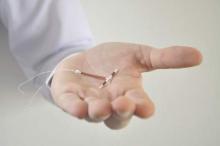WASHINGTON – Many women who underwent post-placental IUD insertion reported little or no pain, regardless of whether they had an epidural during childbirth, according to the findings of a small pilot study.
Dr. Shannon Carr and her colleagues at the University of New Mexico, Albuquerque, assessed 66 women using both a 100-mm visual analog pain scale (VAS) and a four-point Likert verbal rating scale (VRS). They also interviewed a subset of the participants to gather qualitative data about the experience. About half the group received an epidural (36 women) and half did not (30 women).
The VAS scores did not reveal normal distributions and the standard deviations were large, which was not statistically meaningful, according to Dr. Carr. The median scores were 40.5 mm and 2.8 mm in the no-epidural and epidural groups, respectively. But using the four-point pain scale – none, mild, moderate, and severe – the researchers found that 53% of women in the no-epidural group reported pain ranging from none to mild, while 89% of women in the epidural group reported pain in the none-to-mild range.
“What I saw basically reflected what we call the floor effect of the VAS scores in the epidural group. Most of the women hardly had any pain,” Dr. Carr said at the annual meeting of the American College of Obstetricians and Gynecologists. “Women who did not have an epidural reported scores that were all over the map.”
The results help to shed light on what is probably the most common question asked by women considering post-placental IUD insertion – Will it hurt?
“The more we learn about it, the more we can reassure women and counsel them appropriately about what to expect, not only clinically but on a personal level with their labor experience,” Dr. Carr said. “I think that’s really important, and it might promote uptake of the procedure and more women getting really effective contraception before leaving the hospital.”
Qualitative data, based on interviews with 9 women in the no-epidural group and 12 in the epidural group, showed that they had no regrets about the procedure, and most reported that it didn’t detract from their overall labor experience. Instead, most of the women in the study said that holding their newborn baby was a pleasant distraction from the placement of the IUD.
The primary driver for undergoing IUD insertion immediately post partum was convenience. “They wanted to have really good birth control on board before they left the hospital,” Dr. Carr said. “They recognize those logistical barriers to getting to that 6-week postpartum visit.”
The researchers did not report having any financial disclosures.
mschneider@frontlinemedcom.com
On Twitter @maryellenny


